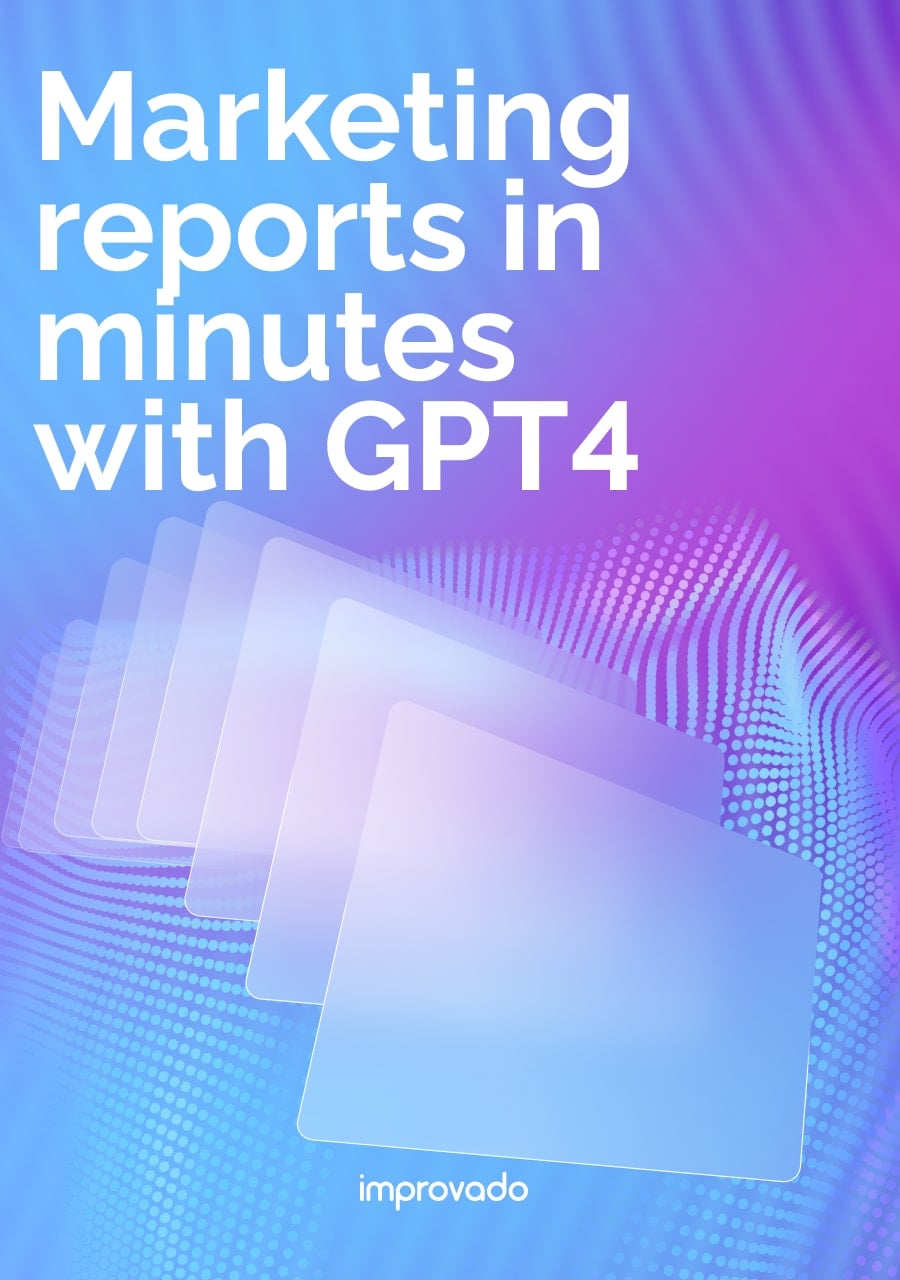Marketing data often lives in dozens of disconnected systems—ad platforms, CRMs, analytics tools, and internal databases. This fragmentation leads to data silos, inconsistent definitions, and governance gaps, making it difficult to trust metrics or run advanced models. Valuable time is spent reconciling discrepancies and preparing datasets instead of extracting insights that drive growth.
This article explores marketing data centralization as the solution to these challenges. It covers the core concepts, business benefits, and implementation steps, along with common pitfalls and how to overcome them.
Key Takeaways
- Data centralization unifies scattered data into one repository for a single source of truth.
- Benefits include improved data quality, faster decision-making, and stronger governance.
- When centralizing data, companies may face challenges like integration complexity, security risks, and ongoing data quality management.
- Automation with platforms like Improvado eliminates manual ETL and reduces reporting time by 80%.
- For marketing leaders, centralization enables holistic ROI measurement; for analytics, it reduces IT overhead by 80%; for operations, it simplifies compliance and governance.
What Is Data Centralization?
The goal is to eliminate silos and create a single source of truth. Rather than pulling fragmented reports from individual platforms, teams can work from a centralized dataset that uses shared taxonomies, naming conventions, and governance rules. This enables faster reporting, cleaner attribution, and more reliable modeling.
How Data Centralization Creates a Single Source of Truth
A single source of truth (SSOT) is only possible when all marketing data is consolidated, standardized, and governed within a central environment.
In fragmented setups, each platform operates with its own definitions, time zones, and attribution logic. This results in conflicting metrics, for example, one system reports a conversion while another doesn’t, or revenue totals differ across dashboards. Without reconciliation, decision-makers are forced to rely on incomplete or inconsistent views of performance.
This process eliminates duplication, fills missing values, and aligns all datasets to a common structure, ensuring downstream reporting and analytics are consistent and trustworthy.
Companies with a true SSOT report:
- 99% fewer discrepancies in reporting,
- 80% reduction in time spent reconciling data and preparing reports,
- 2–3x faster insights from analytics workflows.
Key Benefits of Centralizing Your Data
Centralizing marketing data builds a strategic foundation for growth. This shift enables faster insights, stronger collaboration across functions, and the ability to support advanced analytics and AI-driven decision-making.
The following benefits highlight why centralization is essential for modern marketing operations.
1. Achieve a Comprehensive View of Business Performance
When data is siloed across multiple platforms, each team sees only part of the picture. Paid media reports one set of numbers, CRM data shows another, and revenue systems often don't align.
This fragmented view makes it difficult to connect spend to outcomes or understand how different channels influence the customer journey.
Centralizing data solves this by consolidating all marketing and revenue signals into a single, unified dataset. With every touchpoint, from first ad impression to closed deal, captured and standardized, teams can analyze performance holistically across campaigns, channels, and customer segments.
This comprehensive view enables:
- Accurate cross-channel attribution to see how tactics work together rather than in isolation.
- Full-funnel reporting, linking top-of-funnel engagement to the downstream pipeline and revenue.
- More accurate forecasting by basing models on complete, governed data sets.
2. Improve Data Quality and Consistency
Poor data quality is one of the biggest obstacles to accurate reporting and advanced analytics.
In fragmented environments, naming conventions, taxonomies, and attribution logic vary by platform, leading to discrepancies and unreliable insights. This forces analysts to spend countless hours cleaning and reconciling data manually before any meaningful analysis can begin.
Centralizing data creates a single point of control where quality can be enforced systematically. During data ingestion, data is:
- Validated to identify and correct errors such as missing fields or duplicate records.
- Standardized with consistent naming conventions, date formats, and campaign structures.
- Governed through rules that ensure compliance with internal policies and external regulations like SOC 2, GDPR, or HIPAA.
With clean, consistent data, downstream reporting and modeling become faster, more accurate, and easier to scale.
3. Enhance Data Accessibility and Collaboration
When data is scattered across systems, teams waste time requesting reports or exporting files, slowing down decision-making and creating dependency bottlenecks.
Centralization provides secure, governed access to a single source of truth, allowing marketing, analytics, and leadership teams to work from the same dataset in real time. This improves collaboration by ensuring everyone is aligned on definitions, metrics, and insights, reducing miscommunication and accelerating execution.
The result is faster, more informed decisions and a shared foundation that supports cross-functional initiatives like attribution modeling, budget planning, and campaign optimization.
4. Enable Faster, More Informed Decision-Making
Delayed or incomplete data slows down strategy and execution. When reporting depends on manual exports or fragmented systems, teams often make decisions based on outdated or partial information, increasing the risk of wasted spend and missed opportunities.
With centralized data, performance insights are available in real time, supported by consistent definitions and governed processes. Teams can quickly identify trends, detect anomalies, and forecast outcomes with confidence.
5. Strengthen Data Security and Governance
As marketing stacks grow, so do the risks around data privacy, compliance, and unauthorized access. Managing these risks across multiple disconnected platforms is complex and prone to errors.
Centralizing data creates a controlled environment where permissions, audit trails, and compliance rules are managed in one place. Sensitive data can be segmented, masked, or restricted based on role, while access is monitored and logged for accountability.
With a single governance framework, organizations can enforce consistent policies, meet regulatory requirements like GDPR, SOC 2, and HIPAA, and reduce exposure to security threats, all while maintaining the trust of customers and stakeholders.
The Top Challenges of Data Centralization
While marketing data centralization provides a strong foundation for analytics and decision-making, implementing it at an enterprise scale is inherently complex.
Below are the most critical challenges teams must address to ensure success.
1. Complex Data Integration from Disparate Sources
Enterprise marketing stacks are sprawling, with 120+ MarTech tools on average, spanning ad platforms, CRMs, analytics systems, CDPs, and offline sources. Each data source comes with its own:
- Unique schemas and naming conventions that must be normalized for cross-platform reporting.
- API rate limits and throttling rules that can delay data ingestion or lead to partial loads.
- Frequent schema and endpoint changes that can silently break integrations.
Manual ETL pipelines or in-house integrations are fragile and resource-intensive, often requiring constant monitoring and engineering intervention. As new tools are added or APIs evolve, these pipelines become harder to maintain, resulting in data gaps and unreliable reporting.
2. Ensuring High Data Quality and Accuracy
Centralization only adds value if the data being aggregated is clean, accurate, and standardized. Without rigorous quality controls, a centralized environment can quickly degrade into a “data swamp”—a repository filled with duplicates, missing fields, and conflicting definitions.
Common data quality issues include:
- Mismatched taxonomies across platforms (for example, inconsistent campaign naming).
- Duplicate conversions or inflated spend metrics due to overlapping tracking.
- Gaps caused by missing or incomplete data streams.
Maintaining accuracy at scale requires automated validation, normalization, and deduplication, supported by a clear governance framework.
3. Security Risks and Single Point of Failure
A centralized repository simplifies governance, but it also concentrates risk. If compromised, it exposes the organization’s most sensitive marketing and customer data.
To mitigate this, enterprises must implement:
- Advanced encryption for data in transit and at rest.
- Granular access controls to prevent unauthorized use of sensitive datasets.
- Comprehensive audit trails to track data lineage and user activity.
- Disaster recovery plans and redundancies to ensure business continuity.
Without these safeguards, centralization could inadvertently create a high-value target for breaches and compliance violations.
4. Establishing Effective Data Governance
Centralization without governance simply moves the problem upstream. Without clear policies, teams often revert to creating shadow databases or exporting their own CSV files, undermining the very goal of a single source of truth.
Effective governance requires:
- Defined data ownership and stewardship for each domain and data source.
- Role-based permissions that control who can view, edit, and distribute data.
- Standardized processes and documentation for taxonomy enforcement and schema changes.
- Ongoing governance audits to ensure compliance with SOC 2, GDPR, HIPAA, and internal policies.
When governance is embedded into the centralization strategy, it prevents new silos from emerging and enables scalable, secure collaboration across marketing, analytics, and engineering teams.
How to Centralize Your Data: A 4-Step Strategy
The following four-step strategy provides a structured approach to building a scalable, reliable, and compliant centralization process.
Step 1: Assess Infrastructure and Define Goals
Before selecting tools or architectures, organizations must understand their current data landscape and business requirements.
- Inventory all data sources: Include CRMs, ad platforms, analytics suites, CDPs, e-commerce systems, offline data sources, and finance platforms.
- Map data flows and dependencies: Identify where data originates, how it moves, and where gaps or latency occur.
- Diagnose pain points: Examples include delayed attribution reporting, manual CSV exports, inconsistent campaign naming, or unreliable revenue tracking.
- Define measurable objectives: Establish specific outcomes, such as improved ROI tracking, compliance readiness, or the ability to support advanced models like multi-touch attribution (MTA) or marketing mix modeling (MMM).
This step ensures alignment between technical teams, marketing stakeholders, and leadership, setting a foundation for business-driven architecture decisions.
Step 2: Select the Right Central Repository
Your central repository is the core of your data ecosystem. The choice between a warehouse, lake, or hybrid approach depends on the type, volume, and use cases of your marketing data.
| Repository Type | Best For | Trade-Offs | Examples |
|---|---|---|---|
| Data Warehouse | Structured, analytics-ready data for reporting and dashboards | Less flexible for raw or semi-structured data | Snowflake, BigQuery, Redshift |
| Data Lake | Raw, unstructured, or semi-structured data for future modeling | Requires heavy transformation and governance | Databricks, Azure Data Lake |
| Hybrid (Lakehouse) | Combining raw storage with structured analytics in one environment | More complex setup and maintenance | Databricks Lakehouse, Snowflake Iceberg |
Best practice:
- For BI and reporting, a warehouse provides optimized performance and query speed.
- For data science and machine learning, a lake or hybrid architecture offers the flexibility to store granular, unstructured data alongside processed datasets.
- Many enterprises adopt a modern data stack that blends these approaches to balance agility and control.
Step 3: Implement Integration and Normalization
Integration is the most technically challenging phase, as marketing stacks often involve hundreds of sources with constantly evolving APIs.
- Automate ETL/ELT pipelines: Use dedicated platforms or tools to extract, transform, and load data at scale.
- Standardize taxonomies and schema: Enforce consistent naming conventions for campaigns, spend, and conversions to eliminate cross-platform discrepancies.
- Apply real-time monitoring: Detect anomalies like missing data, broken tracking pixels, or API failures before they impact reporting.
- Version control and lineage tracking: Maintain auditability by tracking every transformation and schema update.
Step 4: Activate Analytics and Reporting
Once data is centralized, it must be accessible and actionable across teams and leadership levels.
- Connect BI and analytics tools: Link your central repository to Tableau, Power BI, Looker, or other BI platforms.
- Enable role-based dashboards: Provide tailored views for marketing, finance, and executives to ensure each team gets insights relevant to their workflows.
- Support advanced models: Implement advanced measurement frameworks like multi-touch attribution (MTA), marketing mix modeling (MMM), and predictive lead scoring directly on top of governed data.
- Leverage AI-powered dashboards: Consider generative dashboards for real-time performance monitoring and anomaly detection.
Automating Data Centralization for Marketing Teams
At enterprise scale, manual data centralization is neither sustainable nor secure.
Marketing stacks often include hundreds of platforms, each with unique schemas, inconsistent naming conventions, and evolving APIs. Maintaining custom ETL pipelines in this environment requires constant engineering intervention, leading to reporting delays, data discrepancies, and significant operational overhead.
Automation is essential for solving these challenges.
A fully automated framework continuously ingests, normalizes, and governs data without manual exports or fragile workflows. It enforces consistent taxonomies, monitors for pipeline failures, and adapts to API changes in real time.
Improvado was purpose-built to automate marketing data centralization. With 500+ pre-built connectors, real-time normalization, and integrated governance features, it provides a single platform to consolidate fragmented marketing, sales, and revenue data.
The result is a scalable single source of truth that supports BI dashboards, attribution models, and advanced analytics without the technical debt of custom-built integrations.
See how Improvado can automate your marketing data centralization at scale. Book a demo to explore how leading enterprise teams streamline operations and accelerate decision-making.
.png)






.png)
